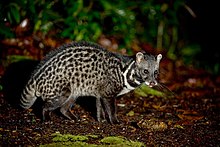மலேய புனுகுப்பூனை
| மலேய புனுகுப்பூனை | |
|---|---|

| |
| உயிரியல் வகைப்பாடு | |
| திணை: | |
| பிரிவு: | |
| வகுப்பு: | |
| வரிசை: | பெலிபார்மியா
|
| குடும்பம்: | விவ்ரெரிடே
|
| பேரினம்: | விவேரா
|
| இனம்: | வி. தாங்காலுன்கா
|
| இருசொற் பெயரீடு | |
| விவேரா டாங்காலுன்கா கிரே, 1832 | |

| |
| மலேய புனுகுப்பூனை பரம்பல் (அடர் பச்சை-வாழக்கூடிய மென்மையான பச்சை- வாழ்வதா நம்பக்கூடிய) | |
மலேய புனுகுப்பூனை (Malayan civet)(விவேரா தாங்காலுன்கா), மலாய் புனுகுப்பூனை மற்றும் கீழை நாட்டு புனுகுப்பூனை என்று அழைக்கப்படும் மலாய் தீபகற்பத்தினைச் சார்ந்த சுமாத்திரா, பங்கா, போர்னியோ, ரிஆ, ஆர்ச்சிபேலேகோ, மற்றும் பிலிப்பீன்சு பகுதிகளில் காணப்படும் ஒருவகைப் பாலூட்டியாகும். பன்னாட்டு இயற்கைப் பாதுகாப்புச் சங்கத்தின் செம்பட்டியலில் இது "தீவாய்ப்புக் கவலை குறைந்த இனமாக" பட்டியலிடப்பட்டுள்ளது. ஏனெனில் இது ஒப்பீட்டளவில் பரவலாகக் காணப்படுகிறது. சீரழிந்த வாழ்விடங்களை சகித்து வாழக்கூடிய இந்த இனம் பல பாதுகாக்கப்பட்ட பகுதிகளில் காணப்படுகிறது.
வகைப்பாட்டியல்
[தொகு]
மலேய புனுகுப்பூனையின் விலங்கியல் பெயர் விவேரா தாங்காலுன்கா என்பதாகும். 1832-ல் கண்டுபிடிக்கப்பட்ட ஒரு மாதிரிக்கு ஜான் எட்வர்டு கிரே இந்தப் பெயரினை வழங்கினார்.[2]
பண்புகள்
[தொகு]மலாய் புனுகுப்பூனையின் வால் மேலே கருப்பாகவும், அடிப்பகுதியில் வளையம் போன்று காணப்படும்.[3]
பரவல் மற்றும் வாழ்விடம்
[தொகு]மலாய் புனுகுப் பூனை இந்தோனேசியா, மலேசியா, புருனே, பிலிப்பீன்சு மற்றும் சிங்கப்பூர் ஆகிய நாடுகளில் காணப்படுகிறது. இது மலேசியாவில், போர்னியோ, பங்கி தீவுகள், லங்காவி தீவு, பினாங்கு தீவு மற்றும் தீபகற்ப மலேசியாவில் காணப்படுகிறது. இது சுமத்ராவிலும் காணப்படுகிறது. இது சுலாவெசி மற்றும் மலுக்கு தீவுகளில் அறிமுகப்படுத்தப்பட்டது. இந்தோனேசிய தீவுகளான சாவகம், பாவல் மற்றும் தெலோக் பாய் மற்றும் பிலிப்பைன்ஸ் தீவான லெய்ட்டிலும் மலாய் புனுகுப் பூனை காணப்பட்டதாக அருங்காட்சியக பதிவுகள் குறிப்பிடுகின்றன.[4] 2012இல், சிங்கப்பூரில் மலேயப் புனுகுப்பூனை காணப்பட்டது ஒருவர் எடுத்த புகைப்படம் மூலம் தெரிய வருகிறது.[5] பிலிப்பீன்சில் உள்ள மலாய் புனுகுப்பூனை போர்னியோவில் தோன்றி இயற்கையாகவே காலனித்துவப்படுத்தப்பட்ட பலவன் தீவில் இருந்திருக்கலாம். மனித அறிமுகம் மூலம் இது பின்னர் பிலிப்பீன்சீலின் மற்ற பகுதிகளுக்கும் பரவியிருக்கலாம்; ஏனெனில் பிலிப்பபீன்சின் தீவுகளுக்கு இடையிலான நில இணைப்பு கடந்த பனிப்பாறை காலத்தில் இல்லை.[6]
மலாய் புனுகுப்பூனைகள் காடுகள், பயிரிடப்பட்ட நிலம் மற்றும் கிராமங்களின் புறப் பகுதிகள் உட்படப் பலவகையான வாழ்விடங்களில் வாழ்கிறது.[7]
சூழலியல் மற்றும் நடத்தை
[தொகு]மலாய் புனுகுப்பூனை தனிமையில் வாழ்பவை, அனைத்துண்ணி மற்றும் முதன்மையாக நிலப்பரப்பில் வாழ்வன.[8] மலாய் புனுகுப்பூனை இரவாடி வகையின. இவை சிறிய முதுகெலும்பி விலங்குகள் மற்றும் முதுகெலும்பிலிகளை உணவாக உண்ணுகின்றன.
அடர்த்தியான காடுகளில் மலாய் புனுகுப்பூனைகள் அதிக அளவில் உள்ளது. இந்தக் காடுகளில் பழங்கள் உள்ளிட்ட உணவு அதிக அளவு காணப்படுகிறது. இக்காடுகளில் உணவின் பெரும்பகுதியைப் பழங்கள் பங்களிப்பதால், பனை புனுகுப்பூனை உள்ளிட்ட போன்ற பிற விலங்குகளுடன் போட்டியை அதிகரிக்கின்றது. மேலும் பனைமர புனுகுப்பூனை நிலப்பரப்பு மலாய் புனுகுப்பூனையைப் போலல்லாமல் மரங்களில் நேரடியாகப் பழங்களைச் சுரண்டக்கூடும்.[9] மலேசிய பெரா ஏரியைச் சுற்றி மலாய் புனுகுப்பூனைகள் காணப்பட்டன. மரவாழ் மென்மையான புனுகுப்பூனைகள் இப்பகுதியில் நிறைந்திருந்தபோதிலும் சிறிதளவும் பாதிப்பில்லை. அதேசமயம் நிலப்பரப்பு, மாமிச அல்லது பூச்சிக்உண்ணி இனங்கள் எதிர்மறையாகப் பாதிப்பினைக் கொண்டுள்ளது.[10]
அச்சுறுத்தல்கள்
[தொகு]நிலவாழ் உயிரினமான, மலேய புனுகுப்பூனை தரைமட்ட பொறி மற்றும் நாய்களைக் கொண்டு வேட்டையாடுதல் ஆகியவற்றால் பெரிதும் அச்சுறுத்தலுக்கு உள்ளாகி உள்ளது. மனித வாழிடங்களில் காணப்படும் புனுகுப்பூனை பொதுவான அச்சுறுத்தல்களிலிருந்து தொடர்ந்து நிலைத்திருக்க முடியும் என்று கணக்கெடுப்பு ஒன்று கூறுகிறது. இந்த இனங்கள் எப்போதாவது உணவுக்காக வேட்டையாடப்படுகின்றன. இது கோழிகளைத் தாக்கும்போது தீங்குயிரியாகக் கருதப்படுகின்றது.
போர்னியோவில், மரங்கள் வெட்டப்படுவதன் விளைவாக மலேய புனுகுப்பூனை பாதிக்கப்படுவதாகத் தெரிகிறது.[11]
பாதுகாப்பு
[தொகு]விவேரா தாங்கலுங்கா மலேசியாவில் 1972ஆம் ஆண்டு வனவிலங்கு பாதுகாப்புச் சட்டத்தின் (WPA) கீழ் பாதுகாக்கப்படுகிறது. இருப்பினும், தீபகற்ப மலேசியாவின் பல கிராமப்புறங்களில் புனுகுப்பூனை ஒரு தீங்குயிரியாகக் கருதப்படுகின்றன. ஏனெனில் இவை சிறிய கால்நடைகள் மற்றும் பழத் தோட்டங்களில் இரையாகப் பயன்படுத்துகின்றன. 1972ஆம் ஆண்டின் WPA இன் பிரிவு 55, விவசாயிகள் தங்கள் சொத்துக்களுக்குச் சேதம் விளைவிக்கும் எந்தவொரு காட்டு விலங்கையும் சுட, விலங்குகளைப் பயமுறுத்தும் நியாயமான முயற்சிகள் மேற்கொண்டபின் அனுமதிக்கிறது.[12]
மேற்கோள்கள்
[தொகு]- ↑ Duckworth, J.W.; Mathai, J.; Wilting, A.; Holden, J.; Hearn, A.; Ross, J. (2016). "Viverra tangalunga". IUCN Red List of Threatened Species 2016: e.T41708A45220284. doi:10.2305/IUCN.UK.2016-1.RLTS.T41708A45220284.en. https://www.iucnredlist.org/species/41708/45220284. பார்த்த நாள்: 19 November 2021.
- ↑ Gray, J. E. (1832). "On the family of Viverridae and its generic sub-divisions, with an enumeration of the species of several new ones". Proceedings of the Committee of Science and Correspondence of the Zoological Society of London 2: 63–68. https://books.google.com/books?id=ZOdJAAAAcAAJ&pg=PA63.
- ↑ Gray, J. E. (1864). "A revision of the genera and species of viverrine animals (Viverridae), founded on the collection in the British Museum". Proceedings of the Scientific Meetings of the Zoological Society of London 1864: 502–579. doi:10.1111/j.1469-7998.1864.tb00409.x. https://archive.org/stream/proceedingsofgen64zool#page/510/mode/2up.
- ↑ Meiri, S. (2005). "Small carnivores on small islands: new data based on old skulls". Small Carnivore Conservation 33: 21–23. http://www.smallcarnivoreconservation.org/sccwiki/images/5/51/Number_33.PDF. பார்த்த நாள்: 2021-03-24.
- ↑ Lim, N. T.; Ouyang, X. (2012). "Occurrence of the Malay civet, Viverra Tangalunga (Mammalia: Carnivora: Viverridae) in Singapore". Nature in Singapore (5): 79–81.
- ↑ Veron, G.; Willsch, M.; Dacosta, V.; Patou, M-L.; Seymour, A.; Bonillo, C.; Couloux, A.; Wong, S. T. et al. (2014). "The distribution of the Malay civet Viverra tangalunga (Carnivora: Viverridae) across Southeast Asia: natural or human-mediated dispersal?". Zoological Journal of the Linnean Society 170 (4): 917−932. doi:10.1111/zoj.12110.
- ↑ Colon, C. P. (2002). "Ranging behaviour and activity of the Malay civet (Viverra tangalunga) in a logged and an unlogged forest in Danum Valley, East Malaysia". Journal of Zoology 257 (4): 473–485. doi:10.1017/S0952836902001073.
- ↑ Kanchanasakha, B., Simcharoen, S. and Tin Than, U. 1998. Carnivores of Mainland South-East Asia. Endangered Species Unit, WWF-Thailand Project Office, Thailand.
- ↑ Colón, C. P. (1999). Ecology of the Malay Civet (Viverra tangalunga) in a logged and unlogged forest in Sabah, East Malaysia. PhD dissertation. Fordham University, New York, USA.
- ↑ Syakirah, S., Zubaid, A., Prentice, C., Lopez, A., Azmin, M. R. and Mohd-Yusof, A. (2000). A small-mammal survey at Tasek Bera, Pahang, Malaysia's first Ramsar site. Malayan Nature Journal, 54: 31–41.
- ↑ Meijaard, E. (ed.). (2005). Life after logging: reconciling wildlife conservation and production forestry in Indonesian Borneo. Center for International Forestry Research
- ↑ Azlan, J. M. (2003). The diversity and conservation of mustelids, viverrids, and herpestids in a disturbed forest in Peninsular Malaysia. Small Carnivore Conservation 29 பரணிடப்பட்டது 2015-01-29 at the வந்தவழி இயந்திரம்: 8–9.
வெளி இணைப்புகள்
[தொகு]
வாழ்ந்து வரும் ஊனுண்ணி இனங்கள் | |||||||||||||||||||||||||||||||||||||||||||||||||||||||||
|---|---|---|---|---|---|---|---|---|---|---|---|---|---|---|---|---|---|---|---|---|---|---|---|---|---|---|---|---|---|---|---|---|---|---|---|---|---|---|---|---|---|---|---|---|---|---|---|---|---|---|---|---|---|---|---|---|---|
| |||||||||||||||||||||||||||||||||||||||||||||||||||||||||
| |||||||||||||||||||||||||||||||||||||||||||||||||||||||||
| |||||||||||||||||||||||||||||||||||||||||||||||||||||||||
| |||||||||||||||||||||||||||||||||||||||||||||||||||||||||
| |||||||||||||||||||||||||||||||||||||||||||||||||||||||||
| |||||||||||||||||||||||||||||||||||||||||||||||||||||||||
| |||||||||||||||||||||||||||||||||||||||||||||||||||||||||
| |||||||||||||||||||||||||||||||||||||||||||||||||||||||||
| |||||||||||||||||||||||||||||||||||||||||||||||||||||||||
Text is available under the CC BY-SA 4.0 license; additional terms may apply.
Images, videos and audio are available under their respective licenses.


